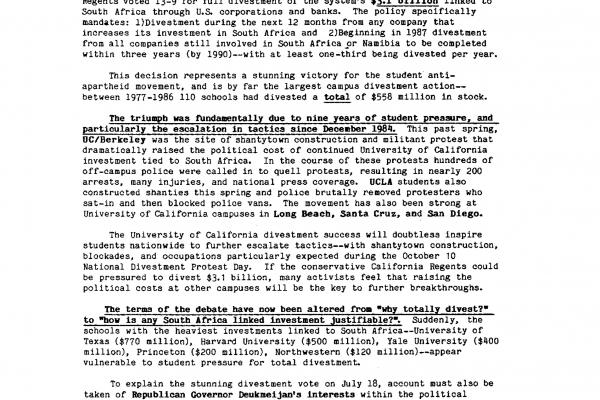In the fall of 1981 I was a freshman at the University of California, Davis. It didn’t take long for me to step into the “Free South Africa” divestment movement sweeping the U.C. system.
I already had some traction with political protest. My first “demonstration” that I can remember was the 1966. I was 3 years old and it was the United Farm Workers march on the California state capitol in Sacramento. I was — and still am — a child of La Causa.
The University of California system had billions of dollars invested in South Africa — as did many U.S. and international corporations and governments. The aim of the divestment movement was to “drain the swamp of the apartheid regime.” The African National Congress and the South African church movement were calling for divestment and sanctions against the South African apartheid regime — even though it would but additional burdens on ordinary people. Millions around the globe responded.
The divestment movement spread like wildfire through the U.C. system. We had regular noon rallies outside the administration offices. And more than once in my college career we blocked the steps to Sproul Hall and were subsequently arrested by campus police with the Davis city police looking on.
The most amazing thing about all that hard work and direct action and perseverance was that we won. On July 18, 1986, on Nelson Mandela’s birthday, the U.C. Regents voted for full divestment of the system’s $3.1 billion. When the U.C. system voted to divest, suddenly a number of other major schools, like Harvard, became vulnerable to a divestment campaign. There was a kind of domino effect that began to happen.
When the South African President P.W. Botha tried to make cosmetic changes to the racial separation laws, the divestment movement didn’t falter. It was a free South Africa or nothing. Then in 1990 the de Klerk regime began to negotiate with the ANC. On Feb. 2, 1990, he made his first public comment announcing his commitment to release Mandela, South Africa’s most famous prisoner. On Feb. 11, Mandela walked free from prison, where he had been sentenced to hard labor for 27 years.
In 1994, South Africans held their first free and democratic elections. People waited in lines for days to vote. Here in the U.S. many of us watched it on television for hours. Just to see 100-year-old South African black women, vote for the first time. It was truly a long walk and a long struggle to freedom.
There had always been strong Christian leadership in the black community against apartheid–Rev. Desmond Tutu, Dr. Manas Buthelezi, Alan Boesak, and Frank Chikane. But, after the Sharpsville massacre in 1960, Beyers Naude, a white Afrikaner Dutch Protestant, stepped forward to lead the white and global church in resistance to apartheid. He brought the World Council of Churches into the freedom struggle. And soon church and Christian communities around the world, including Sojourners, were singing South African Freedom Songs in church. St. George’s Anglican Cathedral in Cape Town and Regina Mundi, the largest Catholic church in South Africa in Soweto became two of the leading “struggle churches” or “people’s churches” where organizers met and prayed and sang and mourned and strategized and healed and went on.
Now, with Mandela dead, these are the churches where the people return to sing, and mourn, and dance, and celebrate. May all our churches be such places. I’m so happy that I am a child of these freedom struggles. Watching the South Africans around the world toyi-toyi — dance — in grief and thanksgiving helps me understand what resurrection means.
Rose Marie Berger, an associate editor at Sojourners, blogs at www.rosemarieberger.com. She's the author of Who Killed Donte Manning? The Story of an American Neighborhood available at store.sojo.net.
Got something to say about what you're reading? We value your feedback!
